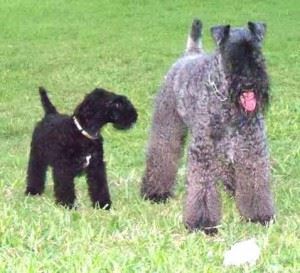(This article, written by Anne Katona, was first published in the AKC Gazette breed column in February, 2005. We are grateful to the author and to the AKC for their permission to publish all the Kerry Blue Terrier Breed Columns on the USKBTC website.)
Blue First The breed name, Kerry Blue, dictates color should be very important to “type.” No other breed can lay claim to the same color, making that distinctive color the breed’s crowning glory. “Up to 18 months any doubt as to whether a dog is black or a very dark blue should be resolved in favor of the dog, particularly in the case of a puppy, and deviations from the correct mature color are permissible without preference and without regard for uniformity.” If an exhibit is under 18 months of age, color is not an issue in judging therefore, color can not be used as a reason to disqualify. The leeway the Standard gives color is considerable however after 18 months a dog should present proper, mature color or it should not be in the ring. The Standard states, “The correct mature color is any shade of blue gray or gray blue from the deep slate to light blue gray, of a fairly uniform color throughout except that distinctly darker to black parts may appear on the muzzle, head, ears, feet and tail. Black on the muzzle, head, ears, tail and feet is permissible at any age.” Breeders refer to this as dark “points” — Some kerries will have darker “points” on a coat of correct color. Black points are acceptable at any age and many breeders find such dogs to be particularly desirable. The Standard gives this feature no preference. “Kerry color, in its process of clearing from apparent black at birth to the mature gray blue to blue gray passes through one or more transitions involving a very dark blue (darker than deep slate—think shot gun metal blue), shades or tinges of brown, and mixtures of these, together with a progressive infiltration of the correct mature color.” Many people expect the black puppy coat to miraculously change overnight into the clear silver or darker blue adult coat. There is no scientific way to predict when the change will be complete. The time needed for this “clearing” of color process varies with each dog. “Thereafter, deviation from it to any significant extent must be severely penalized. Solid black is never permissible in the show ring. Disqualification: Solid black.” The following quote from The Horace J. Perry Commentary on the Kerry Blue Terrier Standard, pages 8 & 9, 1991 says it best. “Of all the requirements set forth in the standard, it seems as if color is the most misunderstood. The cause might be the excessive explanation bolstering the essential and succinct definition which states “ The correct mature color is ANY shade of blue gray or gray blue from deep slate to light blue gray, of fairly uniform color throughout, except that distinctly darker to black parts may appear on the muzzle, head, ears, tail and feet.” All one has to do is to recognize that a mature color is not required before 18 months of age. Perhaps that is why we have dogs up to 18 months of age in puppy sweepstakes even though custom dictates 12 months as the transition from puppy to maturity. The last two paragraphs labor with cautions that seem to confound the reader rather than make the definitions more understandable. The original standard merely states “Color is of great importance; any blue, silver or steel blue. A Kerry must be blue after he is 18 months old.” The United States Kerry Blue Terrier Club official website |


